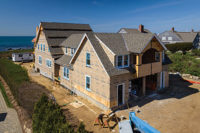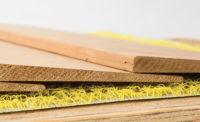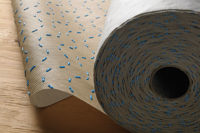Water gets into buildings. It’s an indisputable reality. The effects of inward driven moisture can wreak havoc on the structural integrity, durability and longevity of any building. The aftermath leaves homeowners and property managers struggling to fix problems including rot, mold and mildew. For architects and builders, failing to identify these potential risks and specify solutions to mitigate them can become a significant issue in renovation, as well as in litigation.
The marketplace is filled with a variety of drainable housewraps designed to protect the building enclosure and drain water away from the sheathing. While the assumption is that testing for their efficacy has been thorough, common code standards for housewraps don’t tell the entire story.
A prime example is ASTM E 2273, an optional test standard used to determine the drainage efficiency of EIFS clad wall assemblies. At a base level, the test measures the evacuation of water over a period of time, total drainage efficiency over the spray period and the dry period over 120 minutes. While ASTM E 2273 certainly serves its purpose in measuring the total amount of water that evacuates the wall assembly during that period, measuring drainage speed provides a more accurate prediction of in-situ drainage performance.
Does it Matter How Fast my Wall Drains?
The longer bulk water rests in the wall assembly, the greater the threat to the building. In fact, commonly accepted building science theory supports the notion that a buildup of hydrostatic pressure will almost immediately force water through staple or nail penetrations that fasten a housewrap to sheathing. From there, water will saturate the back of the housewrap and/or the sheathing itself.
Standard housewraps invite these types of problems, as water that cannot drain down their surface will drive inward towards sheathing through fastener locations. Builders will often put cladding tight up against the housewrap without a provision for drainage, dramatically increasing the likelihood of moisture damage in these structures.
Trapped moisture can also be absorbed into the cladding itself. Wood, fiber cement, stone and stucco are considered reservoir claddings and can absorb bulk water remaining in the wall.
Among drainable housewraps, however, variations in time to drain measurements are significant, as recent independent testing of eight drainable housewraps and one flat housewrap conducted by the CTL Group discovered. This series of three tests aimed to evaluate and measure water exiting a mock wall assembly similar to the system used in the EIFS test. Rather than monitoring the total amount of water removed by a housewrap over a set duration, this test was designed to evaluate the following criteria:
- Time to first water (water to drain from top of chamber to bottom)
- Percent of water recovered after 60 seconds
- Time to empty the top containers (24 ounces)
Time to First Water & Amount of Water Recovered
The first measurement evaluated the time to first water, or how long it takes for the first drops of water to exit the mockup. For architects and builders, the results of this test are important because of the immediate threat standing water creates within the wall assembly.
Tests showed that the leading standard flat housewrap, perhaps the most widely recognized and commercially available housewrap in the test, evacuated first water in approximately 40 seconds (Figure 1). That drainage rate registered more than four times slower than the next-slowest WRB in the test. On the other end of the spectrum, it took only 2.4 seconds for HydroGap drainable housewrap to evacuate the first drops of water to the bottom of the assembly. Extrapolate those results to a real-world building, and it’s easy to understand how a 1,600 percent increase in time to first water could negatively impact building life.
The drainage test also measured the amount of water recovered after one minute (Figure 2). Results were similarly stark in contrasting the ability of a standard housewrap to move water through the wall assembly by 0.54 percent after one minute versus a product that moved water through by 93.32 percent in that same minute.
Two products, HydroGap and TamlynWrap drainable housewrap share a common thread: a minimum 1 mm drainage gap that studies have proven optimal for drainage. With this defined gap, builders can continue to meet the increasing demand for tightly insulated, modern homes, and ensure the longevity of a homeowner’s investment by draining the wall assembly appropriately.
Time to Empty
Another indication that points towards the enhancement in overall drainage performance of a drainable housewrap over a standard housewrap can be found in the “time to empty” test. This test was designed to evaluate the total amount of time for a houswrap to remove 24 ounces of water poured in from an elevated chamber approximately 16-inches above grade.
The entirety of the water did not exit the mock wall assembly where the leading standard housewrap was installed in the mockup (Figure 3). The remaining results varied from one to seven minutes, but two systems completely removed water in less than 60 seconds.
In comparison to ASTM E 2273, measuring for time to drain adds greater nuance to the conversation about what makes a drainable housewrap effective and the advantages of creating a gap for proper drainage. While the EIFS standard test showed many of these WRB systems performed similarly, the test parameters did not include time limits for drainage. Evaluating the rate of drainage rather than the final amount alone single-handedly supports the value of drainable housewraps as a building best practice.
Telling the Whole Story
The purpose of conducting these new tests and establishing improved standards is to enhance sustainability in building envelopes and show how incorporating best moisture management practices can help to avoid failures in the future. The fact is water will get past your cladding. Beyond acting as a simple air barrier, how your housewrap performs following a water entry event determines a large part of sheathing integrity, and ultimately, the health of your structure for years to come.
To access the full report conducted by the CTL Group, contact techsupport@obdyke.com.








Report Abusive Comment